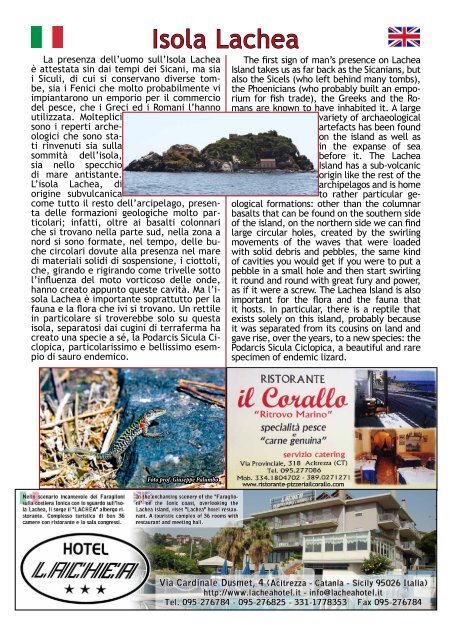Guida turistica Aci Trezza 2013 - Xiphonia Coop. a rl - Turismo ad ...
Guida turistica Aci Trezza 2013 - Xiphonia Coop. a rl - Turismo ad ...
Guida turistica Aci Trezza 2013 - Xiphonia Coop. a rl - Turismo ad ...
Create successful ePaper yourself
Turn your PDF publications into a flip-book with our unique Google optimized e-Paper software.
La presenza dell’uomo sull’Isola Lachea<br />
è attestata sin dai tempi dei Sicani, ma sia<br />
i Siculi, di cui si conservano diverse tombe,<br />
sia i Fenici che molto probabilmente vi<br />
impiantarono un emporio per il commercio<br />
del pesce, che i Greci ed i Romani l’hanno<br />
utilizzata. Molteplici<br />
sono i reperti archeologici<br />
che sono stati<br />
rinvenuti sia sulla<br />
sommità dell’isola,<br />
sia nello specchio<br />
di mare antistante.<br />
L’isola Lachea, di<br />
origine subvulcanica<br />
come tutto il resto dell’arcipelago, presenta<br />
delle formazioni geologiche molto particolari;<br />
infatti, oltre ai basalti colonnari<br />
che si trovano nella parte sud, nella zona a<br />
nord si sono formate, nel tempo, delle buche<br />
circolari dovute alla presenza nel mare<br />
di materiali solidi di sospensione, i ciottoli,<br />
che, girando e rigirando come trivelle sotto<br />
l’influenza del moto vorticoso delle onde,<br />
hanno creato appunto queste cavità. Ma l’isola<br />
Lachea è importante soprattutto per la<br />
fauna e la flora che ivi si trovano. Un rettile<br />
in particolare si troverebbe solo su questa<br />
isola, separatosi dai cugini di terraferma ha<br />
creato una specie a sé, la Podarcis Sicula Ciclopica,<br />
particolarissimo e bellissimo esempio<br />
di sauro endemico.<br />
Isola Lachea<br />
Foto prof. Giuseppe Palumbo<br />
The first sign of man’s presence on Lachea<br />
Island takes us as far back as the Sicanians, but<br />
also the Sicels (who left behind many tombs),<br />
the Phoenicians (who probably built an emporium<br />
for fish tr<strong>ad</strong>e), the Greeks and the Romans<br />
are known to have inhabited it. A large<br />
variety of archaeological<br />
artefacts has been found<br />
on the island as well as<br />
in the expanse of sea<br />
before it. The Lachea<br />
Island has a sub-volcanic<br />
origin like the rest of the<br />
archipelagos and is home<br />
to rather particular geological<br />
formations: other than the columnar<br />
basalts that can be found on the southern side<br />
of the island, on the northern side we can find<br />
large circular holes, created by the swi<strong>rl</strong>ing<br />
movements of the waves that were lo<strong>ad</strong>ed<br />
with solid debris and pebbles, the same kind<br />
of cavities you would get if you were to put a<br />
pebble in a small hole and then start swi<strong>rl</strong>ing<br />
it round and round with great fury and power,<br />
as if it were a screw. The Lachea Island is also<br />
important for the flora and the fauna that<br />
it hosts. In particular, there is a reptile that<br />
exists solely on this island, probably because<br />
it was separated from its cousins on land and<br />
gave rise, over the years, to a new species: the<br />
Podarcis Sicula Ciclopica, a beautiful and rare<br />
specimen of endemic lizard.


